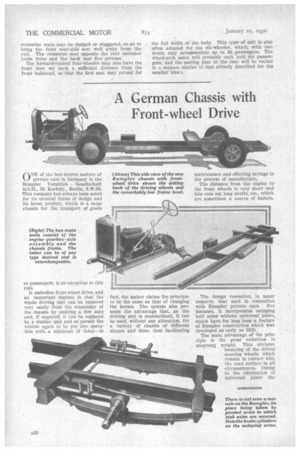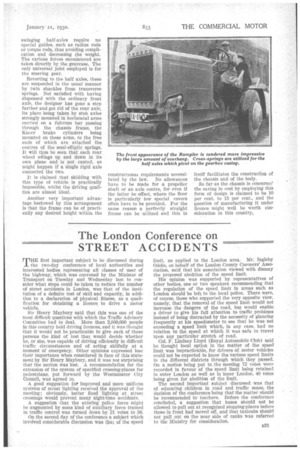A German Chassis with Front-wheel Drive
Page 56

Page 57

If you've noticed an error in this article please click here to report it so we can fix it.
ONE of the best-known makers of private cars in Germany is the Bumpier Vorntrieb Gesellschaft m.b.II., 53, Kochstr., Berlin, S.W.68. This company has always been noted for its unusual forms of design and its latest product, which is a large chassis for the transport of goods
orpassengers, is no exception to this rule.
It embodies front-wheel drive, and an important feature is that the whole driving unit can be removed very easily from the remainder of the chassis by undoing a few nuts and, if required, it can be replaced by a similar unit and so permit the vehicle again to be put into operation with a minimum of delay—in fact, the maker claims the principle to be the same as that of changing the horses. The system also presents the advantage that, as the driving unit is standardized, it can be used, without any alteration, for a variety of chassis of different shapes and sizes, thus facilitating maintenance and effecting savings in the process of manufacture.
The distance from the engine to the front wheels is very short and this cuts out long shafts, etc., which are sometimes a source of failure.
The design resembles, in many respects, that used in connection with Bumpier private cars. For instance, it incorporates swinging half axles without universal joints, which have for long been a feature of Bumpier construction which was developed as early as 1920.
The main advantage of the principle is the great reduction in unsprung weight. This obviates bouncing of the driven: steering wheels, which remain in contact with the road surface in all circumstances. Owing to the elimination of universal joints the swinging half-axles require no special guides, such as radius rods or torque rods, thus avoiding complication and decreasing the weight. The various forces encountered are taken directly by the gearcase. The only universal joint employed is for the steering gear.
Reverting to the half axles, these are suspended in the usual manner by twin shackles from transverse springs. Not satisfied with having dispensed with the ordinary front axle, the designer has gone a step farther and got rid of the rear axle, its place being taken by stub axles strongly mounted in horizontal arms carried on a fulcrum bar passing through the chassis frame, the Knorr brake cylinders being mounted on these arms, to the free ends of which are attached the centres of the semi-elliptic springs. It will thus be seen that each rear wheel swings up and down in its own plane and is not canted,. as might happen if a single rigid axle connected the two.
It is claimed that skidding with this type of vehicle is practically impossible, whilst the driving qualities are almost ideal.
Another very important advantage bestowed by this arrangement is that the frame can be of practically any desired height within the constructional requirements necessitated by the law. No allowances have to be made for a propeller shaft or an axle centre, for even if the latter be offset, where the floor is particularly low special covers often have to be provided. For the same reason a perfectly straight frame can be utilized and this in itself facilitates the construction of the chassis and of the body.
So far as the chassis is concern cc' the saving in .cost by employing this form of design is claimed to be 10 per cent. to 16 per cent., and the question of manufacturing it under licence might well be worth consideration in this country.




















































































































